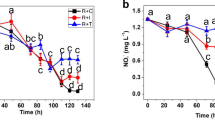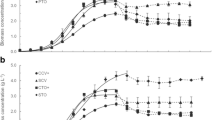Abstract
Municipal wastewater reverse osmosis concentrate (ROC) poses health and environmental risks on its disposal as it contains nutrients and harmful organic compounds at elevated concentrations. This study compared a freshwater microalga Chlorella vulgaris and a marine microalga Nannochloropsis salina in suspended and alginate-immobilised cultures for batch and semi-continuous treatment of the ROC. The immobilised algae gave comparable nutrient removal rates to the suspended cells, demonstrating immobilisation had no apparent negative impact on the photosynthetic activity of microalgae. Semi-continuous algal treatment illustrated that the microalgae could remove significant amounts of nutrients (> 50% and > 80% for TN and TP, respectively), predominantly through algal uptake (> 90%), within a short period (48 h) and generate 335–360 mg DCW L-1 d-1 of algal biomass. The treatment also removed a significant amount of organic matter (12.7–13.3 mg DOC L-1 d-1), primarily (> 65%) through the biotic pathway.



Similar content being viewed by others
References
APHA (2013) Standard methods for the examination of water and wastewater, Theclassics Us
Bagastyo AY, Batstone DJ, Rabaey K, Radjenovic J (2013) Electrochemical oxidation of electrodialysed reverse osmosis concentrate on Ti/Pt IrO2, Ti/SnO2-Sb and boron-doped diamond electrodes. Water Res 47:242–250
Bolch C, Blackburn S (1996) Isolation and purification of Australian isolates of the toxic cyanobacterium Microcystis aeruginosa Kütz. J Appl Phycol 8:5–13
Cai T, Ge X, Park SY, Li Y (2013) Comparison of Synechocystis sp. PCC6803 and Nannochloropsis salina for lipid production using artificial seawater and nutrients from anaerobic digestion effluent. Bioresour Technol 144:255–260
Chevalier P, Proulx D, Lessard P, Vincent W, DE LA Noiüe J (2000) Nitrogen and phosphorus removal by high latitude mat-forming cyanobacteria for potential use in tertiary wastewater treatment. J Appl Phycol 12:105–112
Choi H (2015) Nutrient removal in reverse osmosis concentrates using a biological aerated filter. Water Sci Technol Water Supply 15:302–307
Chung CM, Hong SW, Cho K, Hoffmann MR (2018) Degradation of organic compounds in wastewater matrix by electrochemically generated reactive chlorine species: kinetics and selectivity. Catal Today 313:189–195
Cruz I, Bashan Y, Hernàndez-Carmona G, De-Bashan L (2013) Biological deterioration of alginate beads containing immobilized microalgae and bacteria during tertiary wastewater treatment. Appl Microbiol Biotechnol 97:9847–9858
Delgadillo-Mirquez L, Lopes F, Taidi B, Pareau D (2016) Nitrogen and phosphate removal from wastewater with a mixed microalgae and bacteria culture. Biotechnol Rep 11:18–26
Delrue F, Alvarez-Díaz P, Fon-Sing S, Fleury G, Sassi J-F (2016) The environmental biorefinery: using microalgae to remediate wastewater, a win-win paradigm. Energies 9:132
EPA Victoria (2016) Code of practice – onsite wastewater management. s.l.: Environmental Protection Authority Victoria
Gani P, Mohamed Sunar N, Peralta HM, Abdul Latiff AA, Ab Razak AR (2016) Influence of initial cell concentrations on the growth rate and biomass productivity of microalgae in domestic wastewater
He Q, Yang H, Wu L, Hu C (2015) Effect of light intensity on physiological changes, carbon allocation and neutral lipid accumulation in oleaginous microalgae. Bioresour Technol 191:219–228
Khan SJ, Murchland D, Rhodes M (2009) Management of concentrated waste streams from high-pressuremembrane water treatment systems. Crit Rev Environ Sci Technol 39:367–415
Krzemińska I, Pawlik-Skowrońska B, Trzcińska M, Tys J (2014) Influence of photoperiods on the growth rate and biomass productivity of green microalgae. Bioprocess Biosyst Eng 37:735–741
Kuśtrowski P, Natkański P, Rokicińska A, Witek E (2018) Polymer hydrogel-clay (nano)composites: science and fundamentals.
Lavín PL, Lourenço SO (2005) An evaluation of the accumulation of intracellular inorganic nitrogen pools by marine microalgae in batch cultures. Braz J Oceanogr 53:55–68
Lu J, Fan L, Roddick FA (2013) Potential of BAC combined with UVC/H2O2 for reducing organic matter from highly saline reverse osmosis concentrate produced from municipal wastewater reclamation. Chemosphere 93:683–688
Luo H, Zeng X, Liao P, Rong H, Zhang TC, Jason Zhang Z, Meng X (2019) Phosphorus removal and recovery from water with macroporous bead adsorbent constituted of alginate-Zr4+ and PNIPAM-interpenetrated networks. Int J Biol Macromol 126:1133–1144
Maeng SK, Khan W, Park JW, Han I, Yang HS, Song KG, Choi WJ, Kim S, Woo H, Kim H-C (2018) Treatment of highly saline RO concentrate using Scenedesmus quadricauda for enhanced removal of refractory organic matter. Desalination 430:128–135
Melis A (2002) Green alga hydrogen production: progress, challenges and prospects. Int J Hydrog Energy 27:1217–1228
Nuñez VCJ, Voltolina D, Nieves M, Piña P, Medina A, Guerrero MN (2001) Nitrogen budget in Scenedesmus obliquus cultures with artificial wastewater. Bioresour Technol 78:161–164
Petrovič A, Simonič M (2015) The effect of carbon source on nitrate and ammonium removal from drinking water by immobilised Chlorella sorokiniana. Int J Environ Sci Technol 12:3175–3188
Pradhan S, Fan L, Roddick FA (2015) Removing organic and nitrogen content from a highly saline municipal wastewater reverse osmosis concentrate by UV/H2O2–BAC treatment. Chemosphere 136:198–203
Ruiz-Marin A, Mendoza-Espinosa LG, Stephenson T (2010) Growth and nutrient removal in free and immobilized green algae in batch and semi-continuous cultures treating real wastewater. Bioresour Technol 101:58–64
Sanz-Luque E, Chamizo-Ampudia A, Llamas A, Galvan A, Fernandez E (2015) Understanding nitrate assimilation and its regulation in microalgae. Front Plant Sci 6:899–899
Sayre R (2010) Microalgae: the potential for carbon capture. BioScience 60:722–727
Sheets JP, Ge X, Park SY, Li Y (2014) Effect of outdoor conditions on Nannochloropsis salinacultivation in artificial seawater using nutrients from anaerobic digestion effluent. Bioresour Technol 152:154–161
Smetana S, Sandmann M, Rohn S, Pleissner D, Heinz V (2017) Autotrophic and heterotrophic microalgae and cyanobacteria cultivation for food and feed: life cycle assessment. Bioresour Technol 245:162–170
Solovchenko A, Ismagulova T, Lukyanov A, Vasilieva S, Konyukhov I, Pogosyan S, Lobakova E, Gorelova O (2019) Luxury phosphorus uptake in microalgae. J Appl Phycol 31:2755–2770
Song Y-H, Qiu G-L, Yuan P, Cui X-Y, Peng J-F, Zeng P, Duan L, Xiang L-C, Qian F (2011) Nutrients removal and recovery from anaerobically digested swine wastewater by struvite crystallization without chemical additions. J Hazard Mater 190:140–149
Sousa LLD, Hora DSD, Sales EA, Louisa (2014) Cultivation of Nannochloropsis sp. in brackish groundwater supplemented with municipal wastewater as a nutrient source. Braz Arch Biol Technol 57:171–177
Taisir M, Teo C, Idris A, Yusuf A (2016) Cultivation of Nannochloropsis sp. using narrow beam angle light emitting diode in an internally illuminated photobioreactor. Bioresour Bioprocess 3:1–8
Tam NFY, Wong YS (2000) Effect of immobilized microalgal bead concentrations on wastewater nutrient removal. Environ Pollut 107:145–151
Umar M, Roddick F, Fan L (2014) Recent advancements in the treatment of municipal wastewater reverse osmosis concentrate—an overview. Crit Rev Environ Sci Technol 45
Wang PG, Ji GL, Yu TR (1987) Adsorption of chloride and nitrate by variable charge soils in relation to the electric charge of the soil. Z Pflanzenernaehr Bodenkd 150:17–23
Wang X-X, Wu Y-H, Zhang T-Y, Xu X-Q, Dao G-H, Hu H-Y (2016) Simultaneous nitrogen, phosphorous, and hardness removal from reverse osmosis concentrate by microalgae cultivation. Water Res 94:215–224
Wang X-X, Zhang T-Y, Dao G-H, Hu H-Y (2018) Tolerance and resistance characteristics of microalgae Scenedesmus sp. LX1 to methylisothiazolinone. Environ Pollut 241:200–211
Wen X, Du K, Wang Z, Luo L, Xu Y, Zhang D, Geng Y, Li Y (2016) Effective cultivation of microalgae for biofuel production: a pilot-scale evaluation of a novel oleaginous microalga Graesiella sp. WBG-1. Biotechnol Biofuels 9
Whitton R, LE Mével A, Pidou M, Ometto F, Villa R, Jefferson B (2016) Influence of microalgal N and P composition on wastewater nutrient remediation. Water Res 91:371–378
Wong YK, Ho YH, Ho KC, Leung HM, Yung KKL (2017) Maximization of cell growth and lipid production of freshwater microalga Chlorella vulgaris by enrichment technique for biodiesel production. Environ Sci Pollut Res 24:9089–9101
Wright SW, Jeffrey SW, Mantoura RFC (1997) Phytoplankton pigments in oceanography: guidelines to modern methods. UNESCO Pub, Paris
Yasar F, Abdullah AK (2013) The potential of Chlorella vulgaris for wastewater treatment and biodiesel production. Pak J Bot 45:461–465
Yi K, Fan Z, Tang J, Chen A, Shao J, Peng L, Zeng Q, Luo S (2018) The elucidation of surrounding alginate gels on the pollutants degradation by entrapped nanoscale zero-valent iron. Colloids Surf B: Biointerfaces 171:233–240
Yu J, Wang J, Jiang Y (2017) Removal of uranium from aqueous solution by alginate beads. Nucl Eng Technol 49:534–540
Zhao F, Yu B, Yue Z, Wang T, Wen X, Liu Z, Zhao C (2007) Preparation of porous chitosan gel beads for copper(II) ion adsorption. J Hazard Mater 147:67–73
Acknowledgements
The authors wish to thank Barwon Water for the assistance in collecting ROC samples for this research.
Author information
Authors and Affiliations
Corresponding author
Additional information
Responsible Editor: Angeles Blanco
Publisher’s note
Springer Nature remains neutral with regard to jurisdictional claims in published maps and institutional affiliations.
Electronic supplementary material
ESM 1
(DOCX 596 kb)
Rights and permissions
About this article
Cite this article
Mohseni, A., Kube, M., Fan, L. et al. Potential of Chlorella vulgaris and Nannochloropsis salina for nutrient and organic matter removal from municipal wastewater reverse osmosis concentrate. Environ Sci Pollut Res 27, 26905–26914 (2020). https://doi.org/10.1007/s11356-020-09103-6
Received:
Accepted:
Published:
Issue Date:
DOI: https://doi.org/10.1007/s11356-020-09103-6




